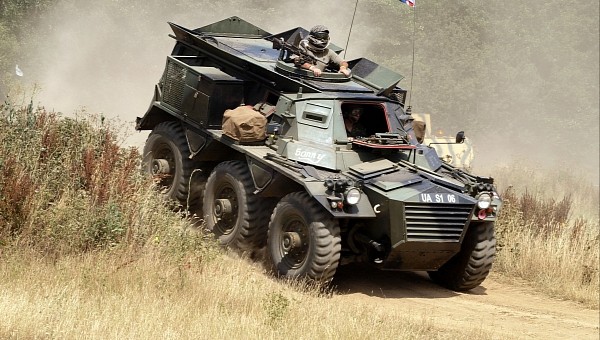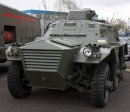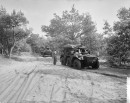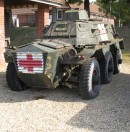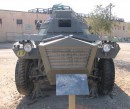If a hoard of HUMVEEs rolled through your average American city center, the response would be nothing short of pandemonium. Happily, Americans seldom get close to the conditions needed for army trucks to start patrolling the streets. But other places in the world can't claim the same comfort.
In some places, military armored cars rolling through urban streets are a defining national image. Places like Northern Ireland and South Africa, for instance. This is the story of the Alvis FV603 Saracen, the poster vehicle for the Northern Irish Troubles, the abolition of South African Apartheid, and so many pivotal social changes of the last 40 years.
As you'll find, it can be pretty hard to separate the vehicle from the actions of the people driving them in this instance. When you have the weight of these kinds of pivotal events in human history bearing down on you, this tends to happen. The Saracen 6x6 comes from a time when multiple facets of history were converging on Great Britain and impacting like a ton of bricks. From constant threats of nuclear annihilation by the Soviet Union to heated and often violent tensions between the Irish Republican Army (IRA) and the British Army, Britain, and its surrounding non-British neighbors were at a crossroads.
In a world where the Troubles of Northern Ireland never took place, the Saracen could have made its name in any number of battles the world at large was due to fight post-1952. But alas, history had other plans for the design. The Saracen's designer and manufacturer, the Alvis Car and Engineering Company, essentially served the same role AM General did for the U.S. Military come the time of the HUMVEE's development. So to say, the British government used Alvis an in-house expert in armored military vehicle manufacturing, as a lifeline to supplement its armies.
As makers of high-quality luxury sedans and drop-top sports coupes before the Second World War, Alvis enjoyed a similar reputation to Bentley and Aston Martin alongside its rep for building war vehicles. Interestingly, Alvis also built custom grand prix racing cars with futuristic trinkets like front-wheel drive and fully independent rear suspension. This was in the 1930s, mind you. It sounds like tech straight out of the late 60s.
Add in a stint building turbofan jet engines under license from Gnome-Rhone of France, and Alvis has plenty of building experience that translates well into building vehicles of war. With dimensions of 4.8 meters (15.74 ft) long and 2.54 meters (8.3 ft) wide and tipping the scales at 11 tons, the Saracen was a slab of British beef manufactured in Coventry, England. A place that's also known for being home to Jaguar, Rover, Land Rover, Triumph, and Hawker-Siddeley, at different points in the past.
With that kind of engineering know-how going around, the Saracen was built by some of the most skilled engineers in all of Britain. As a replacement for the AEC heavy armored car, the Saracen served this duty admirably. With its great bulk and imposing Rhinoceros-like front grille, many no-good doers would cut and run before the Saracen's weapons could even be fired.
As a combat APC built on a largely modular chassis, the Saracen shares a great many components underneath its armored skin with another icon of the Northern Irish Troubles, the Saladin, developed by Crossley Motors and built by Alvis. Unlike some other six-wheeled war machines and even some civilian custom pickup trucks, the Saracen was a true 6x6 vehicle with a dedicated drive axel and independent torsion bars for each pair of wheels. Powering this chunky beast was a Rolls-Royce B80 gasoline-powered inline eight-cylinder engine.
This brutish 5.75-liter engine was rated at a (probably underrated) 160 horsepower and a substantially higher amount of torque. Interestingly, the same engine found its way inside 15 examples of the 18 Rolls-Royce Phantom IVs built between 1950 and 1956. In the ostensibly far less luxurious Alvis Saracen, this beefy engine propelled this 6x6 brick to a top speed of 72 kph (44.7 mph) on smooth pavement.
With up to 16 mm of rolled homogenous steel armor plating, Saracens could shrug off the vast majority of small arms fire that dissidents in the British Colonies could realistically get their hands on. On top of that, an armament of a single Browning M1919 30 caliber machine gun or a single L37 GPMG 7.62mm machine gun served as a formidable line of defense in the scenario a Saracen's crew of ten, including the driver and commander, was under attack by terrorist groups.
From the moment the Alvis Saracen entered production, it was due to be trialed through the crucible of real combat. No sooner were Saracens leaving production room floors in Coventry did anti-British Partisans in Malaya heat up their attacks. The Malayan Emergency in modern-day Malaysia was the Saracen's first real combat, but it'd be far from the last.
In civil wars in Nigeria, Sri Lanka, and Lebanon, but also on the Jordanian side of the Yom Kippur war, Saracens found themselves in the thick of some of the worst warfare post World War II that the world had seen. But the vehicle would earn its greatest spotlight not in any of these bloody wars, but rather in the perpetual social unrests of South Africa and Northern Ireland. In South Africa alone, the South African Defense Force (SADF) ordered as many as 280 Saracens between 1953 and 1956.
For the next 35 years, these APCs would aid in the suppression of anti-apartheid protest movements that often turned violent if left unresolved. These anti-apartheid movements would one day come to be led by Nelson Mandela in the early 1990s. Ironically, this was around the same time South African Saracens were all retired. In Northern Ireland, the escalation of tensions between IRA separatists and British military police in the late 1960s shed a global spotlight on the Saracen it'd never had before.
In an effort to stave off IRA attacks and to keep peace on the streets of Belfast, the Saracen operated with mixed results. Though no doubt a formidable sight to see in cramped urban streets, IRA attacks continued, usually followed by equal retaliatory force from the British Army and police. Most notably, during the Bloody Sunday Massacre of January 1972, British Army Saracens were seen collecting the bodies of protestors that had only moments before been fired upon.
Through these violent encounters all across the world, the Saracen earned infamy in the cultures of the places it saw service. The Saracen is often the subject of pro-IRA folk music, most notably the song "My Little Armalite," in which Saracens, flanked by Saladins and Ferret Armored Cars, are depicted as being ambushed by IRA members donning Armalite rifles. Even over in America, the police forces of Tulsa, Oklahoma, San Francisco, and California, employed one Saracen each in SWAT roles.
For an armored car that looks like an NPC vehicle in a Call of Duty game, the Saracen routinely found itself among some of the most pivotal urban battles of the 20th century. Periods that shaped Great Britain and its former colonies in ways that still have profound impacts on the world today. Though it's just a machine, the Saracen's role as a "Player 1" in the great video game of 20th-century history has turned it into something far greater than a glorified Army Truck.
As you'll find, it can be pretty hard to separate the vehicle from the actions of the people driving them in this instance. When you have the weight of these kinds of pivotal events in human history bearing down on you, this tends to happen. The Saracen 6x6 comes from a time when multiple facets of history were converging on Great Britain and impacting like a ton of bricks. From constant threats of nuclear annihilation by the Soviet Union to heated and often violent tensions between the Irish Republican Army (IRA) and the British Army, Britain, and its surrounding non-British neighbors were at a crossroads.
In a world where the Troubles of Northern Ireland never took place, the Saracen could have made its name in any number of battles the world at large was due to fight post-1952. But alas, history had other plans for the design. The Saracen's designer and manufacturer, the Alvis Car and Engineering Company, essentially served the same role AM General did for the U.S. Military come the time of the HUMVEE's development. So to say, the British government used Alvis an in-house expert in armored military vehicle manufacturing, as a lifeline to supplement its armies.
As makers of high-quality luxury sedans and drop-top sports coupes before the Second World War, Alvis enjoyed a similar reputation to Bentley and Aston Martin alongside its rep for building war vehicles. Interestingly, Alvis also built custom grand prix racing cars with futuristic trinkets like front-wheel drive and fully independent rear suspension. This was in the 1930s, mind you. It sounds like tech straight out of the late 60s.
With that kind of engineering know-how going around, the Saracen was built by some of the most skilled engineers in all of Britain. As a replacement for the AEC heavy armored car, the Saracen served this duty admirably. With its great bulk and imposing Rhinoceros-like front grille, many no-good doers would cut and run before the Saracen's weapons could even be fired.
As a combat APC built on a largely modular chassis, the Saracen shares a great many components underneath its armored skin with another icon of the Northern Irish Troubles, the Saladin, developed by Crossley Motors and built by Alvis. Unlike some other six-wheeled war machines and even some civilian custom pickup trucks, the Saracen was a true 6x6 vehicle with a dedicated drive axel and independent torsion bars for each pair of wheels. Powering this chunky beast was a Rolls-Royce B80 gasoline-powered inline eight-cylinder engine.
This brutish 5.75-liter engine was rated at a (probably underrated) 160 horsepower and a substantially higher amount of torque. Interestingly, the same engine found its way inside 15 examples of the 18 Rolls-Royce Phantom IVs built between 1950 and 1956. In the ostensibly far less luxurious Alvis Saracen, this beefy engine propelled this 6x6 brick to a top speed of 72 kph (44.7 mph) on smooth pavement.
From the moment the Alvis Saracen entered production, it was due to be trialed through the crucible of real combat. No sooner were Saracens leaving production room floors in Coventry did anti-British Partisans in Malaya heat up their attacks. The Malayan Emergency in modern-day Malaysia was the Saracen's first real combat, but it'd be far from the last.
In civil wars in Nigeria, Sri Lanka, and Lebanon, but also on the Jordanian side of the Yom Kippur war, Saracens found themselves in the thick of some of the worst warfare post World War II that the world had seen. But the vehicle would earn its greatest spotlight not in any of these bloody wars, but rather in the perpetual social unrests of South Africa and Northern Ireland. In South Africa alone, the South African Defense Force (SADF) ordered as many as 280 Saracens between 1953 and 1956.
For the next 35 years, these APCs would aid in the suppression of anti-apartheid protest movements that often turned violent if left unresolved. These anti-apartheid movements would one day come to be led by Nelson Mandela in the early 1990s. Ironically, this was around the same time South African Saracens were all retired. In Northern Ireland, the escalation of tensions between IRA separatists and British military police in the late 1960s shed a global spotlight on the Saracen it'd never had before.
Through these violent encounters all across the world, the Saracen earned infamy in the cultures of the places it saw service. The Saracen is often the subject of pro-IRA folk music, most notably the song "My Little Armalite," in which Saracens, flanked by Saladins and Ferret Armored Cars, are depicted as being ambushed by IRA members donning Armalite rifles. Even over in America, the police forces of Tulsa, Oklahoma, San Francisco, and California, employed one Saracen each in SWAT roles.
For an armored car that looks like an NPC vehicle in a Call of Duty game, the Saracen routinely found itself among some of the most pivotal urban battles of the 20th century. Periods that shaped Great Britain and its former colonies in ways that still have profound impacts on the world today. Though it's just a machine, the Saracen's role as a "Player 1" in the great video game of 20th-century history has turned it into something far greater than a glorified Army Truck.
